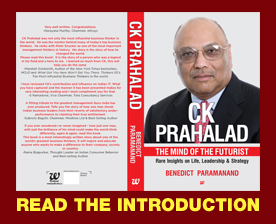 Rajat K Baisya, author of Branding in a Competitive Marketplace
Rajat K Baisya, author of Branding in a Competitive Marketplace
Books by professionals with rich and varied experience usually have useful insights and perspectives to teach and share. Rajat K Baisya, author of Branding in a Competitive Marketplace (Sage 2013), has done just that. The author was names “Best Professor in Marketing Management” by UTV Bloomberg in B-School Excellence awards recently. Excerpts of his conversation with ManagementNext
It is said we are still an under-branded market – What is your advice to brand custodians on why they should spend more?
There are brands in India which have global potential but that potential has never been explored and the reasons can be many including management myopia, lack of resources, our limited understanding of the global market and fear of facing failures.
The attempt that we now see in post liberalization era that large Indian FMCG companies are only trying to take over or acquire brands and businesses abroad but hardly any sustained effort for creating global brand. But the time has possibly come for businesses to look beyond domestic market and explore elsewhere following various models. Marketing investment is made to build brand in the longer run and it is difficult to say how much investment behind a brand is sufficient. We believe that any amount of judicious investment behind a brand building exercise is not wasted. In the longer run it always pays.
Indians are the most value conscious consumers – how difficult is it for brand managers in India to address them
Really difficult. Pricing therefore is very critical for success here. Pricing has to be considered as strategic tool rather than only to reflect the value perception of the product. About 20 percent product failures are attributable to wrong pricing. When Coke and Pepsi introduced Rs 5 a bottle (Chota Cola) market boomed and sales went up many fold. But it was found to be not economically viable and companies in due course of time withdrawn from this low price option.
Indians are highly price conscious and marketers even found that consumers here are not that much willing to pay a price for even innovations. Any price increase decisions has to be taken very carefully as it can have significant impact on volume. Marketers try to contain the cost escalation to hold on the price line. But good margin is required to support the brand by allocating reasonable amount of resources so that brand achieves its natural potential. It is the task for the brand marketers to establish the desired price-value-benefit equation in the minds of target consumers. For example, too frequent price discount can impact value perception.
What are the new way of measuring return on spend on branding?
Measuring brand value is definitely a better way to know where brand stands amongst its own competitive set and there are various models available for that valuation. But the impact on brand value will be seen on a longer term of brand promotion and positive impact can come only if right strategies for brand building are followed. In the shorter run it is necessary to see whether brand has delivered the desired objective of growth, market share and contribution to business. At what stage of its life cycle the product currently will dictate what measures are ideal for the brand.
A power brand will gain leadership and will also produce significant profit for the business. It is not easy to determine the effectiveness of marketing spend because it is a dynamic situation where all variables are also changing. In ultimate analysis brand has to produce financial performance. In the short run I would put market share and in the long run the financial performance would be most important. Of course, cost of acquiring incremental market share will be a good learning for the businesses and it has to make good sense to the business also.
What’s your advice to today’s young brand managers in India?
I always advise youngsters that they will have to sleep and dream with the brand. They will have to be most knowledgeable people in the business on the brand that they are required to handle. Only having knowledge of marketing and brand management practices will not be enough to create a success story. They also must know everything about competing brands and their likely move in the market place and their strengths and weaknesses. They are required to very closely monitor the performance of the brand against the desired criteria and take corrective actions as necessary. And most importantly they should be the instrument for constant innovation on the brand offering and benefits and rejuvenate the brand in every two to three years. Only then they can expect some results.











Recent Comments